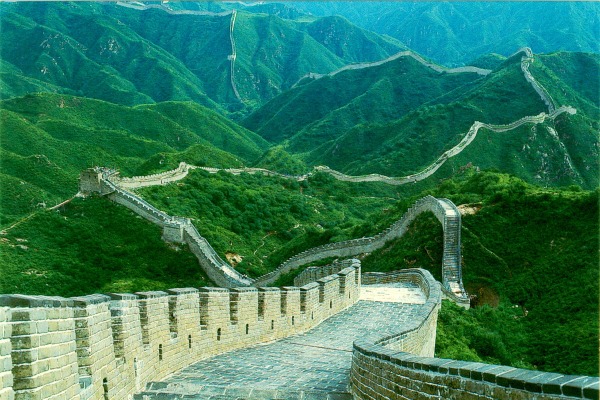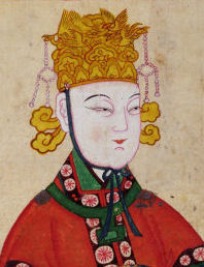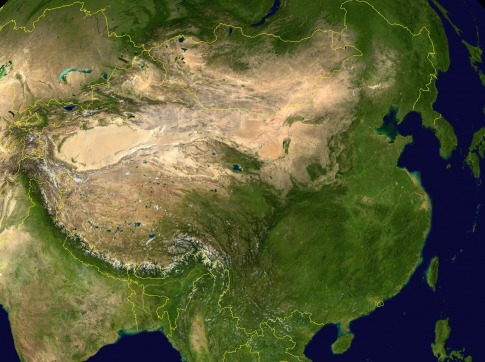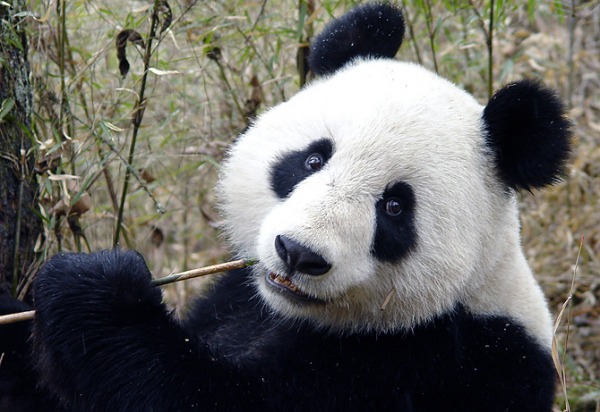
Ah, yes, there you are. Welcome to China! This country has come up with many things that we use today, like gunpowder, kites, and paper. It's an interesting time in history indeed. Oh, below is a picture of the Great Wall, perhaps China's greatest achievement. It stretches across China's deserts, plains, mountains, and valleys for over 3,000 miles. That's a long way! Scientists today estimate that almost 8 million people died building the Great Wall under the Ming Dynasty.
Vocabulary
Period of Disunion - time of disorder that followed collapse of the Han Dynasty
Grand Canal - canal linking northern and southern China
porcelain - thin, beautiful pottery
woodblock printing - form of printing in which an entire page is carved into a block of wood
gunpowder - mixture of powders used in guns, explosives, rockets, fireworks, firearms, canons
compass - instrument that uses the earth's magnetic field to show direction
bureaucracy - body of unelected government officials
civil service - service as a government official
scholar-official - an educated member of the government
isolationism - policy of avoiding contact with other countries
Important People
Empress Wu (625-705) - only woman to rule China; empress during Tang Dynasty; very severe (below)
Genghis Khan (c.1162-1227) - ruler of Mongols who attacked China and other parts of Asia
Kublai Khan (1215-1294) - Mongol ruler who completed conquest of China; founded Yuan Dynasty
Zheng He (c.1371-1433) - Chinese admiral during Ming Dynasty; led great voyages that spread China's fame
Geography
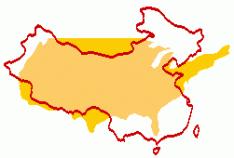
China is the second largest country in Asia (after Russia), and the third largest in the world. It is actually almost exactly the same size as the United States. (See picture at right) The eastern half China includes fertile lowlands, foothills, mountains, deserts, steppes, subtropical areas, and a long coastline with many small islands. The western side is full of basins, massifs, and some of the highest plateaus on Earth. There are several major rivers, such as the Chang Jiang (otherwise known as the Yangzi), the Xi, the Yellow, and the Huang He. China is surrounded by:
North - Gobi Desert
East - Pacific Ocean (and Yellow Sea)
South - South China Sea
West - Himalayas
Below is a physical map of China. You can see areas such as the Gobi Desert (top left), and the more tropical areas and foothills in the east.
Climate
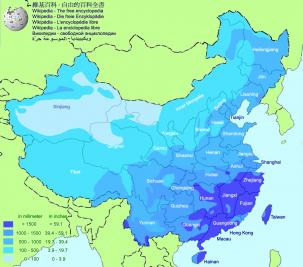
Just like its terrain, China's climate is extremely diverse. With subtropics in the south and subarctic in the north, the weather often varies. There are five main temperature zones: Cold-temperate zone, Mid-temperate zone, Warm-temperate zone, Subtropical zone, and Tropical Zone. Annual rainfall is shown on the map at left. Based on precipitation, there are four main sections: wet area, semi-wet area, semi-dry area, and dry area. This map does not show the sections, but in inches of rain.
Religion
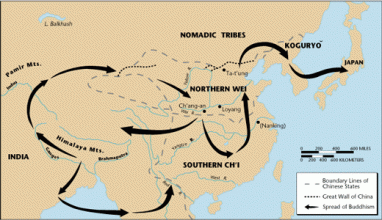
One of the world's major religion spread throughout China during the Period of Disunion- Buddhism. People in trouble turned eagerly for new ideas and an easier way of life. During the Sui and Tang Dynasties, Buddhism influenced China in their art, literature, and architecture. From 400 to 845 is known as the Age of Buddhism, only ending when a Tang emperor burned many Buddhist texts and temples. But even that did not end the spread of Buddhism. People gradually began blending it with other cultures. (see right for spread of Buddhism)
A popular philosophy in China was known as Confucianism. It's founder, Confucius, believed that everyone should focus on proper conduct, respect for elders, education, and government service. There were five main relationships, that between: ruler and subject, parent and child, husband and wife, sibling and sibling, friend and friend. Lastly, he believed that relationships will be harmonious if people are loyal, honest, courteous, faithful, and obedient. During the Sui and early Tang Dynasties, Confucianism was more influential than Buddhism.
A later branch of Confucianism was Neo-Confucianism. It joined Confucianism, Buddhism, and Daoism to make a "new" religion. This was present in the Song Dynasty, and became the official government teachings.
China was also known for following Daoism. Laozi, the founder, put an emphasis on the link between people and nature. This was supposed to help people understand the world, the things in it, and the people around them.
Inventions

China can be credited for many of inventions, lots of which are still used today. If I gave you the whole list, we would be here all day. But I'll just give you a brief introduction of the kinds of things they created.
Paper Money (Song) - Original name was "flying monkey"; used as exchange certificates for merchants;
Matches (Sui) - Made of little sticks of pinewood impregnated with sulfur
Circulation of Blood (Qin) - discovered that blood circulated the body from the heart
Brandy and Whiskey (Tang) - Alcohol came from frozen wine, and the remaining liquid was used to create more alcoholic drinks
Kites (Sui)- Shaped like birds; could deliver messages; stayed up in air for up to three days
Rockets (Yuan) - Made of fireworks connected to a 4 foot bamboo stick with an arrowhead, balancing weight, and feathers
Silk (Shang) - Brought to Europe by Silk Road in 500 AD
Porcelain (Song and Tang) - Clay pottering
Paper (Han) - One of the most wanted trading items; spread to all of Eurasia (pictured above); current paper used today (first paper invented by Egyptians out of papyrus)
Printing (Tang and Song) - Block printing (Tang) and movable type (Song) were both invented by the Chinese
Gunpowder(Tang) - Used for canons in Europe and firecrackers in China
Compass (Tang) - Used for navigation, mainly over sea
Agricultural Achievements
During the Song Dynasty, ways of farming became very advanced. Things like the dragon backbone pump and new irrigation systems made work in the fields faster and more efficient. More lands became dedicated to cultivation, allowing more crops to grow. Things like cotton were soon planted in abundance, along with the normal crops of rice. The Song Dynasty ensured that most people went to bed every night with a full belly.
Government
The Song Dynasty improved the government system in China. They called it a bureaucracy, which was a body of unelected officials. People could only get into this by passing a series of civil service examinations. These tests were mainly on their grasp of Confucianism and other related ideas. Students spent years studying for these exams, and only a few made it to the top. But passing the tests made them a scholar-official, one of the highest members of society. Once an educated member of the government, they ran offices, maintained roads, updated records, or collected taxes. But they were also looked up upon for guidance and support. They were often very wealthy, for many sought their aid. Anyone could become a scholar-official, but they had to go through years of studying to get to that spot.
Trade
Trade played a large role in Chinese society, especially during the Sui and Tang Dynasties. The Grand Canal was a common use of transportation of farm products and other goods. Also, trade routes went over land to India and Southwest Asia. Others went to Korea and Japan. China's exports included rice, tea, spices, jade, and silk. Silk was perhaps the most wanted thing in Asia, and other countries would give almost anything to have it. For example, China received wool, glass, silver, and gold in exchange for their marvelous silk. During the Song Dynasty, sea trade became more common, and their newly developed china could be sent to more and more places.
Animal of the Day: Ha, so here's an adorable pandaaa! I didn't take this picture, but I wish I did....Ancient China didn't really use pandas, but he's so huggable! But he is on here anyway, cause he's just so fuzzy~
